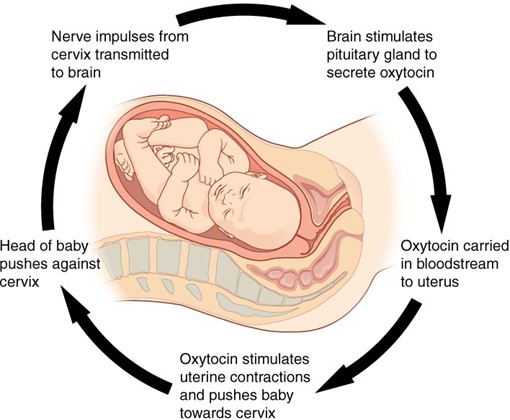Which of the following illustrates a positive feedback mechanism?
Body temperature control.
Control of blood sugar.
Uterine contractions during childbirth.
Maintaining blood pressure.
The Correct Answer is C
Uterine contractions during childbirth illustrate a positive feedback mechanism.

A positive feedback mechanism is a process in which the end products of an action cause more of that action to occur in a feedback loop.
This amplifies the original action.
For example, when a woman goes into labor, the pressure of the baby’s head on the cervix stimulates nerve impulses that travel to the brain and trigger the release of oxytocin, a hormone that causes the uterus to contract.
The contractions increase the pressure on the cervix, which stimulates more nerve impulses, more oxytocin, and more contractions.
This cycle continues until the baby is delivered.
Choice A is wrong because body temperature control is an example of a negative feedback mechanism, which is when the end results of an action inhibit that action from continuing to occur.
For example, when the body temperature rises above normal, the skin sweats, and blood vessels dilate to release heat.
This lowers the body temperature back to normal and stops sweating and dilation.
Choice B is wrong because control of blood sugar is also an example of a negative feedback mechanism.
For example, when the blood sugar level rises after a meal, the pancreas secretes insulin, a hormone that helps cells take up glucose from the blood.
This lowers the blood sugar level back to normal and stops the insulin secretion.
Choice D is wrong because maintaining blood pressure is another example of a negative feedback mechanism.
For example, when the blood pressure drops due to blood loss or dehydration, the heart beats faster and stronger, and the blood vessels constrict to increase the blood pressure.
This restores the blood pressure back to normal and stops the heart rate and vessel constriction.
Nursing Test Bank
Naxlex Comprehensive Predictor Exams
Related Questions
Correct Answer is B
Explanation
Monocytes are a type of agranulocytes, which are white blood cells that lack visible granules in their cytoplasm.
Agranulocytes also include lymphocytes, which are involved in adaptive immunity.
Choice A is wrong because basophils are a type of granulocytes, which are white blood cells that have granules in their cytoplasm.
Granulocytes also include neutrophils and eosinophils, which are involved in innate immunity.
Choice C is wrong because neutrophils are also a type of granulocyte.
Neutrophils are the most abundant white blood cells and are responsible for phagocytizing bacteria and fungi.
Choice D is wrong because eosinophils are also a type of granulocytes. Eosinophils are involved in allergic reactions and parasitic infections.
Normal ranges for white blood cells vary depending on age, gender, and health status, but generally, they are between 4,000 and 11,000 cells per microliter of blood.
Correct Answer is C
Explanation
The thyroid gland secretes triiodothyronine (T3), which is one of the two main thyroid hormones that affect almost every physiological process in the body.

T3 is the more metabolically active hormone produced from thyroxine (T4), which is the other thyroid hormone.
Choice A is wrong because the adrenal gland secretes hormones such as cortisol, adrenaline, and aldosterone, which are involved in stress response, blood pressure regulation, and metabolism.
Choice B is wrong because the pancreas secretes hormones such as insulin, glucagon, and somatostatin, which are involved in blood glucose regulation and digestion.
Choice D is wrong because the parathyroid gland secretes parathyroid hormone (PTH), which is involved in calcium and phosphate homeostasis.
Normal ranges for T3 levels vary depending on the laboratory and the method of testing, but they are usually between 100 and 200 nanograms per deciliter (ng/dL) for total T3 and between 2.3 and 4.2 picograms per milliliter (pg/mL) for free T.
Whether you are a student looking to ace your exams or a practicing nurse seeking to enhance your expertise , our nursing education contents will empower you with the confidence and competence to make a difference in the lives of patients and become a respected leader in the healthcare field.
Visit Naxlex, invest in your future and unlock endless possibilities with our unparalleled nursing education contents today
Report Wrong Answer on the Current Question
Do you disagree with the answer? If yes, what is your expected answer? Explain.
Kindly be descriptive with the issue you are facing.
